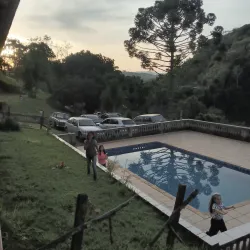Crime and Pollution in Santa Isabel
The following data and statistics on crime, pollution, and overall safety in Santa Isabel are derived from a combination of trusted public sources and insights gathered from user contributions.
This comprehensive approach helps provide a balanced view of the city's crime rates, environmental concerns, air quality, and public safety. By aggregating information from government reports, environmental studies, and direct feedback from residents, we aim offer an up-to-date and thorough analysis of key factors impacting quality of life in Santa Isabel.
Crime Data in Santa Isabel
Crime Perception and Concerns
In 2024, Santa Isabel presents a unique case in terms of crime perception, with data indicating an exceptionally stable crime environment. This consistent perception suggests no significant changes in public safety concerns.
Residents report a balanced sense of security both during the day and at night, highlighting a community experience free from prevalent crime-related anxiety.
Some notable concerns include:
- Property Crimes - Property crimes are not reported as a significant concern, reflecting a community environment with minimal anxiety over theft, burglaries, or related incidents.
- Drug-Related Issues - Drug-related issues appear to have no significant impact on Santa Isabel's public safety perception, indicating effective management of substance-related concerns.
- Violent Crimes - Concerns about violent crimes, such as assault or robbery, are not prominent, indicating a secure environment where such offenses do not heavily weigh on the residents' peace of mind.
- Public Safety - Santa Isabel displays a rare balance in public safety, with no particular time of day eliciting increased fear or attention from the community.
Crime Trends and Safety
- Rising Crime Concerns - Residents exhibit a rare optimism concerning crime trends, with data showing no prevalent fear of increasing crime rates or burgeoning crime issues.
- Specific Fears - Specific fears, including those based on racial, ethnic, or religious grounds, are notably absent, suggesting a harmonious societal environment.
Summary of Crime in Santa Isabel
In conclusion, Santa Isabel's crime landscape remains stable without significant issues in property, violent crimes, or drug-related offenses. The data underscores a peaceful community where public safety initiatives have effectively maintained a secure environment.
Crime Rankings
The crime ranking by city for Brazil is based on a continuously updated index, incorporating data up to 36 months old and calculated twice a year. Cities are ranked on a scale from "very low" to "very high" crime levels, with safety being the inverse, where a high safety index indicates a safer city.
Pollution Data in Santa Isabel
Air Quality and Pollution Levels
Santa Isabel stands out with its neutral pollution data, reflecting a stable urban environment with no heightened concerns over air quality. This points towards managed pollution levels and effective local environmental policies.
Residents reveal no pronounced worries over particulate matter or the implications of air quality on health, suggesting confidence in the air quality management.
- PM2.5 (Fine Particulate Matter) - PM2.5 levels do not trigger health warnings or specific resident concerns, indicative of well-regulated urban emissions and a focus on air purity.
- PM10 (Coarse Particulate Matter) - Likewise, PM10 measurements align with acceptable standards, supporting the overall stability in pollution levels, aiding in a quality living environment.
Waste and Noise Pollution
The issue of noise pollution, often overwhelming in urban areas, appears managed in Santa Isabel, with residents not expressing heightened dissatisfaction.
Concerns about garbage disposal are minimal, indicating efficient waste management systems and cleanliness initiatives that maintain urban tidiness.
- Garbage Disposal Satisfaction - Garbage disposal satisfaction remains neutral, reflecting an effective waste management strategy ensuring cleanliness across the city.
- Noise and Light Pollution - Noise and light pollution are controlled, contributing to a balanced lifestyle without excessive disturbances found in larger urban centers.
Green Spaces and Water Quality
Green spaces present a neutral yet valued aspect of Santa Isabel’s urban life, ensuring residents have access to recreational areas without expressing particular satisfaction or displeasure.
Drinking water quality and accessibility seem to evoke neither significant praise nor concern, denoting reliable utility provision and water purity.
- Green and Parks Quality - Green areas maintain their role in the community, fostering a sense of relaxation and environmental appreciation without standing out as extraordinary.
- Drinking Water Quality - Drinking water quality is reliably consistent, suggesting competent management in maintaining water safety and accessibility for all residents.
Pollution Rankings
The pollution ranking for Brazil is based on a combination of visitor perceptions and data from institutions like the World Health Organization. The Pollution Index estimates overall pollution levels by considering air and water pollution, garbage disposal, and other factors, with air pollution given the highest weight, while the Pollution Exp Scale uses an exponential function to highlight extremely polluted cities.
"Key Takeaways"
Santa Isabel’s crime and pollution data for 2024 shows a well-balanced city life with minimal disturbances from crime or environmental concerns.
The city manages to achieve a harmonious urban environment, offering residents a peaceful lifestyle with consistent public safety and environmental qualities.
Continuous efforts to maintain this balance in crime prevention and pollution control will be key to sustaining Santa Isabel’s commendable urban quality of life.



















